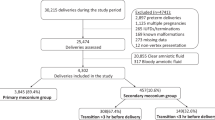Abstract
Purpose of study
To assess the maternal and perinatal complications associated with meconium-stained amniotic fluid (MSAF) in low-risk women in labor.
Methods
This prospective cohort study was conducted at CMC Hospital, Vellore, India. Two hundred low-risk women who had artificial or spontaneous rupture of membranes after admission with MSAF were included in the study. Two hundred similar women with clear liquor were taken as controls. The primary outcomes considered were the incidence of chorioamnionitis and endomyometritis in the mothers. The secondary outcomes included postpartum hemorrhage and retained placenta in the mothers and respiratory distress, meconium aspiration, sepsis, and NICU admission in the newborn. Statistical analysis was done using Fischer exact test. Odds ratio, 95% confidence interval, and P value were estimated.
Results
Compared to controls, those with MSAF had significantly higher rates of chorioamnionitis (2 vs. 8%, P = 0.006) and endomyometritis (3 vs. 9.5% P = 0.007). Among the secondary end points, only neonatal respiratory distress (8.5 vs. 1.5%; P = 0.001) and meconium aspiration (4 vs. 0%; P = 0.007) were found to be significantly increased in the meconium group.
Conclusion
Statistically significant increased incidence of chorioamnionitis and endomyometritis in women with MSAF in labor established in our study strongly supports the use of prophylactic antibiotics in these women to prevent immediate and long-term consequences.

Similar content being viewed by others
References
James D, Steer P, Weiner CP. High risk pregnancy management options. 4th ed. Amsterdam: Elsevier; 2011. p. 1135–40.
Monen L, Hasaart TH, Kuppens SM. The aetiology of meconium-stained amniotic fluid: pathologic hypoxia or physiologic foetal ripening? (review). Early Hum Dev. 2014;90(7):325–8.
Romero R, Yoon BH, Chaemsaithong P, et al. Bacteria and endotoxin in meconium-stained amniotic fluid at term: could intra-amniotic infection cause meconium passage? J Matern Fetal Neonatal Med. 2014;27(8):775–88.
Brabbing-Goldstein D, Nir D, Cohen D, et al. Preterm meconium-stained amniotic fluid is an ominous sign for the development of chorioamnionitis and for in utero cord compression. J Matern Fetal Neonatal Med. 2017;8:1–4.
Hiersch L, Krispin E, Aviram A, et al. Effect of meconium stained amniotic fluid on low risk pregnancies at term. Am J Perinatol. 2016;33(4):378–84.
Vain NE, Batton DG. Meconium “aspiration” (or respiratory distress associated with meconium-stained amniotic fluid?). Semin Fetal Neonatal Med. 2017;11:S1744-165X.
Hiersch L, Krispin E, Linder N, et al. Meconium-stained amniotic fluid and neonatal morbidity in low-risk pregnancies at term: the effect of gestational age. Am J Perinatol. 2017;34(2):183–90.
Hiersch L, Krispin E, Aviram A, et al. Effect of meconium-stained amniotic fluid on perinatal complications in low-risk pregnancies at term. Am J Perinatol. 2016;33(4):378–84.
Pariente G, Peles C, Perri ZH, et al. Meconium-stained amniotic fluid—risk factors and immediate perinatal outcomes among SGA infants. J Matern Fetal Neonatal Med. 2015;28(9):1064–7.
Hiersch L, Melamed N, Rosen H, et al. New onset of meconium during labor versus primary meconium-stained amniotic fluid—is there a difference in pregnancy outcome? J Matern Fetal Neonatal Med. 2014;27(13):1361–7.
Wu HC, Shen CM, Wu YY, et al. Subclinical histologic chorioamnionitis and related clinical and laboratory parameters in preterm. Pediatr Neonatol. 2009;50(5):217–21.
Siriwachirachai T, Sangkomkamhang US, Lumbiganon P, Laopaiboon M. Anibiotics for meconium stained amniotic fluid in labour preventing maternal and neonatal infections. Cochrane Database Syst Rev. 2010;8(12):1–19.
Siriwachirachai T, Sangkomkamhang US, Lumbiganon P, Laopaiboon M. Antibiotics for meconium-stained amniotic fluid in labour for preventing maternal and neonatal infections. Cochrane Database Syst Rev. 2014;6(11):1–24.
Acknowledgements
Ms. Grace Rebecca for statistical analysis.
Author information
Authors and Affiliations
Corresponding author
Ethics declarations
Conflict of interest
All authors declare that they have no conflict of interest.
Ethical Standards
All procedures followed were in accordance with the ethical standards of the responsible committee on human experimentation (institutional and national) and with the 1975 Declaration of Helsinki, as revised in 2008 (5).
Informed Consent
Informed consent was obtained from all patients for being included in the study.
Additional information
Kavitha Abraham is an Assistant Professor, Elsy Thomas is a Professor, Jessie Lionel is a Professor and HOD at Department of Obstetrics and Gynecology, Christian Medical College and Hospital, Vellore, India.
Rights and permissions
About this article
Cite this article
Abraham, K., Thomas, E. & Lionel, J. New Evidence to Support Antibiotic Prophylaxis in Meconium-Stained Amniotic Fluid in Low-Risk Women in Labor a Prospective Cohort Study. J Obstet Gynecol India 68, 360–365 (2018). https://doi.org/10.1007/s13224-017-1043-y
Received:
Accepted:
Published:
Issue Date:
DOI: https://doi.org/10.1007/s13224-017-1043-y




